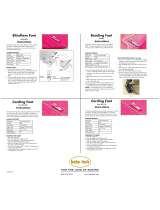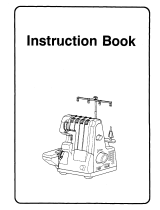
T
A
B
L
E
O
F
C
O
N
T
E
N
T
S
4
Table of Contents (Cont.)
Converting from 3-Thread to 2-Thread Overlock............................................ 36
2-Thread Flatlock - Wide ................................................................................ 37
2
-Thread Flatlock - Narrow............................................................................. 38
Blanket Stitch - Decorative Stitch.................................................................... 39
Ladder Stitch - Decorative Stitch .................................................................... 40
Wave Stitch..................................................................................................... 41
Converting from Normal Serging to Wave ...................................................... 41
3-Thread Wave Stitch ..................................................................................... 42
3-Thread Rolled Wave Stitch .......................................................................... 43
3-Thread Reversed Wave Stitch..................................................................... 44
CHAIN/COVER STITCH - Express Stitches.......................................................... 45
Chain Stitching........................................................................................... 45/46
Chain Stitch - Tension Adjustment ................................................... 46
Cover Stitch - Right Narrow - 3mm........................................................... 47/48
Cover Stitch Tension Adjustment ...................................................... 48
Cover Stitch - Left Narrow - 3mm .............................................................. 49/50
Cover Stitch Tension Adjustment ...................................................... 50
Cover Stitch - Wide - 6mm......................................................................... 51/52
Cover Stitch Tension Adjustment ...................................................... 52
Triple Cover Stitch - 6mm .......................................................................... 53/54
Triple Cover Stitch Tension Adjustment ............................................ 54
COMBINATION STITCH - Expressive Stitches .................................................... 55
4-Thread Safety Stitch ............................................................................... 55/56
5-Thread Safety Stitch ............................................................................... 57/58
7-Thread Wave Stitch ................................................................................ 59/60
7-Thread Reversed Wave Stitch................................................................ 61/62
8-Thread Stitch .......................................................................................... 63/64
Expressive Stiches:
Chain/Cover Stitches Combined with Overlock Stitches ......
65
Expressive Combinations .......................................................................... 65/66
TECHNIQUES ......................................................................................................... 67
Turning Corners - Chain Stitch ....................................................................... 67
Turning Corners - Cover Stitch ....................................................................... 67
Turning Outside Corners - Overlock ............................................................... 68
Turning Inside Corners - Overlock.................................................................. 68
Flat Hemming - Cover Stitch........................................................................... 69
Hemming in the Round - Cover Stitch ............................................................ 69
Blind Hemming - Overlock.............................................................................. 70
Sewing Curves - Overlock .............................................................................. 70
Inserting Tapes - Overlock .............................................................................. 71
Inserting Tapes - Cover Stitch......................................................................... 71
Flatlock "Decorative" - Overlock ..................................................................... 72
Securing Ends - Overlock.......................................................................... 73/74
Securing Chain and Cover Stitching............................................................... 75
Notes .............................................................................................................. 76
SPECIALTY THREADS........................................................................................... 77
Using Specialty Threads ................................................................................. 77
Lightweight Threads .............................................................................. 77
Medium Weight Threads........................................................................ 77
Heavyweight Threads............................................................................ 77
Thread Cradle for Loopers ............................................................................. 78
Looper Threading Tool.................................................................................... 79
Bypassing the Threading Port ........................................................................ 80
Specialty Thread Guide Chart.................................................................... 81/82
MAINTENANCE ...................................................................................................... 83
Troubleshooting ......................................................................................... 83/84
Replacing Needles ......................................................................................... 85
Replacing Cutting Blades ............................................................................... 86
Replacing LED Lighting .................................................................................. 86
Cleaning.......................................................................................................... 87
TECHNICAL DATA.................................................................................................. 88
Technical Data ................................................................................................ 88
STITCH SELECTION CHART................................................................................. 89
Chart for Stitch Selection Setting for Chain/Cover and Combination Stitches 89/90
























